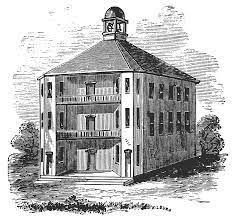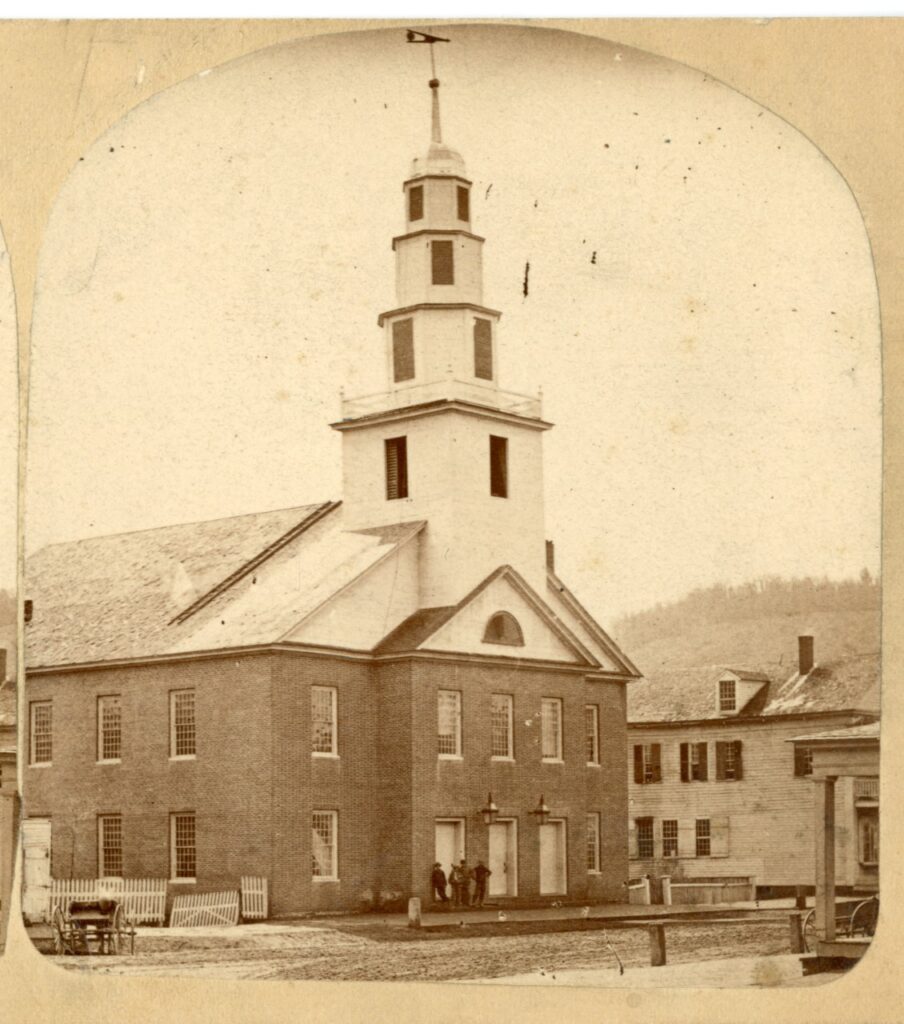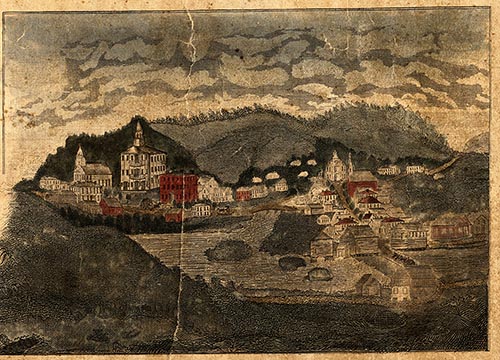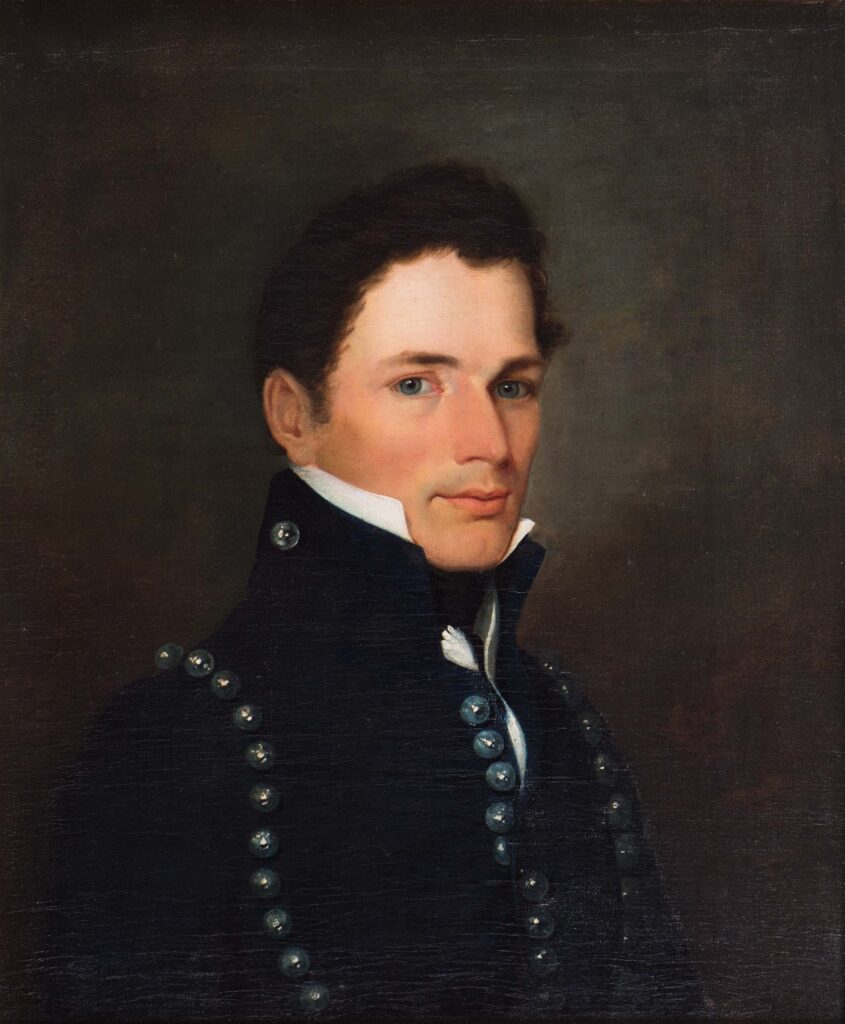– 1822 – Military Academy Cadets hike from Norwich to Montpelier
A Long Walk to Montpelier – 1822 by Paul Heller
On October 11, 1822 the cadets from Captain Partridge’s American Literary, Scientific, and Military Academy left Norwich, Vermont to embark on an eight-day march to Montpelier and back. The roundtrip excursion encompassed 100 miles, and festivities in Montpelier concluded with a formal ball at the Union House in honor of the students. The Union House was a hotel at the corner of Main and School Streets in the capital city. Approximately 110 students made up the marching column, accompanied with wagons for provisions and a rolling cannon used to announce the arrival of the cadet corps as they approached a town.
Alden Partridge was an original thinker in 19th century American military history. His steadfast belief in a citizen soldiery led him to found his own military school in his home town of Norwich, Vermont. Born there in 1785, he attended Dartmouth College, across the Connecticut River and then the U.S. Military Academy. Partridge graduated from West Point and became a Professor of Mathematics there as well as acting Superintendent. When he refused to relinquish command after a new Superintendent was appointed, he was court-marshalled and returned to Vermont to establish his own military school. Partridge’s Academy, in existence since 1819, was chartered as Norwich University in 1834 and moved to Northfield in 1866 after a fire destroyed the Norwich campus.
Partridge believed in physical as well as mental fitness and incorporated extended field trips for his students. Opportunities in the field allowed for practical instruction in geology, natural history and engineering. At West Point he led his students on marches around New York’s Hudson River Valley and elsewhere. Partridge soon incorporated the “Pedestrian Tour” into the curriculum of his new academy at Norwich and on October 6, 1821 the entire student body made a two-day expedition to Woodstock, Vermont where the local newspaper noted of the cadets, “from the youngest to the oldest, they exhibited the same manner of dignity which marks so emphatically the aspect and demeanor of their inimitable instructor.”
Just over one year later the corps left Norwich to march to Montpelier. They passed through Strafford and on to Chelsea where they spent their first night. They had been invited to Montpelier by Joseph Howes on behalf of a committee of prominent Montpelier citizens including Timothy Hubbard, Daniel Baldwin, and E.P. Walton, a newspaper publisher and general of the Vermont Militia. Howes’ letter of invitation to Partridge asked that the cadets come when the legislature was in session and promised “accommodation and refreshment for yourself and pupils in respectable houses during your stay.” Partridge, perhaps, sensed an opportunity to lobby the legislature for support for his new institution and organized this next excursion in short order, setting out for Montpelier just nine days after receiving the invitation.
A detailed account of the excursion was unearthed by Norwich archivist Gail Weise. It is a letter by Samuel Pitkin, a second-year cadet from East Hartford, Connecticut. It begins:
Dear Mamma, On Friday, October 11th at 9 o’clock am, the corps of cadets left the barracks yard to commence their march to Montpelier, the Capital of Vermont. We were divided into 8 companies, attended by 6 baggage wagons, etc. The morning was fine and the road good, for a number of miles where it passed over continual hills…The land bordering the road was occasionally cleared and neat log houses erected but in general our route was through woods variegated with every shade from a scarlet to a delicate buff. About 11 crossed a small but rapid stream called “Bloody Brook” on account of its having been once reddened with the blood of 12 of the first settlers in Norwich massacred by Indians in 1775.
At noon the students found themselves in the village of Hartford (11 miles from Norwich), and Pitkin “found an excellent dinner provided on a long table placed in the center of the town green.” The cadets performed “an evolution of the line”, infantry drill, as a way of paying for their dinner followed by an address by Captain Partridge. Pitkin remarked of Hartford, “this village is simply situated, like others in the vicinity, in a basin two miles in length and ½ in width, formed by the surrounding hills, which rise in height from three to four hundred feet. Our dinner being finished, commenced marching at 2 o’clock.” As the afternoon wore on many cadets availed themselves of the wagons feeling footsore or otherwise exhausted.
As dusk fell the weary cadets found themselves approaching Chelsea. Cannon fire alerted the cadets to fall-in, but with darkness fast descending on them, they had trouble making ranks. They marched into the town at a double-quick time about 8:00pm, and by the light from the windows of the houses in the village they soon saw themselves surrounded by the inhabitants who greeted the students by ringing their bells and firing a cannon. The cadets were billeted with local families and dismissed for the night. Sam Pitkin concludes his entry for October 11th, “marched this day 23 miles.”
He noted that the following morning “the rain poured down in torrents, but felt refreshed with a good night’s sleep and a good breakfast.” The rain abated, and the cadet corps left Chelsea by 10 am. Pitkin’s company was the advance guard, and they were soon wet through when the rain resumed. They encountered two men who had spent the night in their wagon and were disturbed by the uneasiness of their horse. By the light of a lantern they had spied the eyes of a catamount “which they kept at bay by shaking their bear skins.”
Pitkin notes that they “saw the source of the Onion River (Winooski) on which Montpelier is situated. The Cadets arrived at Barre about 3 in the afternoon “and partook of some refreshment.” Their stay was brief as Partridge wanted to arrive in Montpelier before dark. Rather than perform their evolution of the line, they departed with a blast from their cannon as the rain again fell; “the road muddy, slippery and discouraging.”
The thought of soon arriving at Montpelier excited many a stiff limb to move with activity, and induced numbers to walk who otherwise would have been on the wagon. At half past five, the advance guard came within sight of the Montpelier Light Infantry, and halted for the main body. We were soon formed in companies and proceeded onward joyfully, although stiffly, to the place where we trusted our weary feet would find rest.
The Montpelier Light Infantry led the cadet corps the two miles into Montpelier, as the local citizenry drove their chaises, wagons, and horses out to meet them. “The street was crowded with people in such numbers as to render it difficult for our flanks to march.” The cadets formed an “open column of companies and marched down Main Street at a double-quick time.” Their arrival was saluted with cannon fire and the ringing of the State House bell.
The corps wheeled on to State Street and crossed the bridge over the North Branch of the Winooski and “on to the State House Square.” The assembled throng heard an address by Captain Partridge and from members of the committee who had invited them to town. “We were afterwards billeted out and dismissed for the night. Marched this day 23 miles.”
The following day was Sunday and the cadets went to a service at the brick church (now the site of Bethany Church) and heard a sermon delivered by Chester Wright who was soon to lose his pulpit due to his strident opposition to Freemasonry.
On Monday were more demonstrations of military drills and the cadets were then invited to visit the observers gallery at the State House. “We heard a bill read on the propriety of lending Captain Partridge 2 or more cannon with 100 stand of arms, subject to be returned at the will of the legislature. This bill was referred to a select committee. At 2 pm we fell in by open columns of companies, right in front, for the purpose of being reviewed by his Excellency, the Governor. After marching past and saluting his Excellency and accomplishing the usual number of wheels, and performed the various street firings to the evident approbation of the spectators, especially to the gratification of the country fellows who declared we were the darndest, neatest looking things they ever see.”
That evening Partridge delivered a well-attended lecture on the Battle of Waterloo at the brick church.
Tuesday saw the cadets again at parade, as Pitkin recalled, “marched through State, on to the northern extremity of Main St. crossed the Onion, into Water St, and returned through Main, and State, streets, to the Court House square, towards evening formed a Parade, and dismissed with orders to be prepared for marching in the morning.” In the evening Captain Partridge lectured on a proposal for national defense. The Watchman reported on Partridge’s remarks:
He was opposed to large standing armies as dangerous and inexpedient, and in favor of a well- disciplined militia. He considered the efficiency of the militia very much to consist in the military knowledge and discipline of the officers.
Following the lecture, the cadets were feted at a ball at the Union House, by (according to the Watchman) “citizens and gentlemen of distinction from abroad. They were gratuitously quartered, during their stay, in private families, where their amiable manners and correct deportment has left an impression that speaks volumes.”
The corps left Montpelier Wednesday morning, marching in formation after hearing a “fervent prayer” offered by Rev. Chester Wright. On the return route they passed through Berlin, Williamstown and Brookfield, enduring rain and snow. That night they found refuge in a tavern in Randolph. Pitkin noted, they “had an excellent supper provided at the expense of the inhabitants.” As the cadets huddled around the various fireplaces drying their clothes, an alarm was sounded. “The house was immediately in great confusion, some were seriously injured rushing out of the doors. Fortunately the chimney only was on fire – a blaze rushed out of it 12 feet in height, lighting the village and the country around for a considerable distance.”
After a fine breakfast the corps left Randolph about 9 am, arriving in Sharon about 4 pm. They were billeted out for the night and left for Norwich at 9 on Thursday. The sight of the South Barracks “occasioned three hearty cheers and much rejoicing from our crippled corps, who left it gaily eight days since with a lively step and fine spirits.”
In subsequent years the cadet corps made marches to Concord, New Hampshire; Burlington, Vermont; New York City; Hartford, Connecticut; and New Haven, Connecticut.
Samuel L. Pitkin was born in E. Hartford, Connecticut in 1803. According to Ellis’s History of Norwich University (1911) “he attended the schools of Hartford and entered the “Academy” in 1821, graduating in 1823. He was in business for 25 years and banking for several more, He also served in the Connecticut State Militia, rising to the rank of Major General. He served in the Connecticut House of Representatives as well as the State Senate. Married with two sons, he died in 1845. A gifted writer, his letters comprise a valuable resource in the Norwich University Archives.
Photo Credits
Alden Partridge – Norwich University Archives
Samuel Pitkin – Internet
Old Brick Church – VHS
Sarah Watrous painting – VHS
Edwin Ferry Johnson – Norwich University Archives






